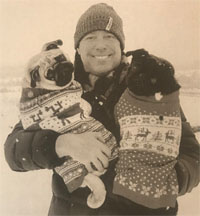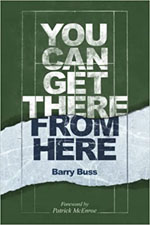Memories of Robert
By Barry Buss

On Monday morning, September 16th, 2024, tennis lost one of its iconic figures: famed coach Robert Lansdorp. Here are a few words about the legendary teacher to so many of our sport's greatest players.
If you came of age during the tennis boom, Robert Lansdorp was a fixture on the professional tennis scene, developing one of America's first teen prodigies inTracy Austin.
Based in Southern California, Robert was the West Coast figurehead of the Boom's two great migrations of the late 1970's. In the east was Nick Bollettieri and his eponymous Academy in Bradenton, Florida, the first international full-time tennis academy for junior development.
In the west, there was Robert Lansdorp, who was based at West End Tennis Club in the South Bay area of Southern California. Before Tupac and Biggie, Bollettieri and Lansdorp were the original East Coast/West Coast rivals.
Two outsized egos, two different development philosophies. Bollettieri believed in the academy model, bringing talented teens together in a culture of hyper-competitiveness, a survival of the fittest mentality, where the best of the best would soar the highest on a crash course with greatness.
Robert believed differently. He believed tennis was best-learned one-on-one on a back court, coach-and-player, where minds and souls could be molded.
Field of Dreams
Families sent their kids to live and train at the NBTA. Families relocated to the South Bay to hopefully capture some of Robert's champion developing magic. Tennis' version of A Field of Dreams. If you build it, they will come. And come they did, from all corners of the world.
Tennis was taught differently back then. There were very few coaches, even fewer who knew what they were doing.
But Robert did, with an uncanny eye for talent and an excellent mind for the game. He had and knew his limitations, focusing more on what he excelled at and what be most effective for that era's game. A stickler for technique, discipline, and toughness, he had a style.

Get low, take the ball early, drive it hard, flat, deep through the court...repeat. But that was just the tennis.
Robert pushed his players hard, not out of some sadistic tendencies, though it sure could seem that way. He drove his players hard to teach them to push themselves, to show them how tough they were and how deep they could dig.

He taught guts, for he knew championships were not won on talent alone. You had to be tougher than your opponent. You needed a deep belief in yourself. And if a man of Robert's stature professed his belief in you, that was empowering and meant something, often enough to get you across the line.
A giant of a man with a booming, intimidating voice, his presence demanded respect. He filled every room he was in. With a tremendous sense of humor and an infectious laugh, he could hold court for hours on end, spinning tale after tale to his rapt audience. He was a showman, but he performed best on life's smaller stages.
He had no desire to be a coach of all the people, just his people. He was his most charismatic and effective one-on-one, away from the spotlights of fame and fortune, where he could spin out his magic, and did he ever.
Teaching was different back in Robert's time. If a player got a private lesson a week, that was a big deal. Only a select few would get two in a week. Robert was in such high demand that parents would take their kids out of school to get time with the self-proclaimed coach of champions. The lengths people would go to for a sweet set of groundies.
As tennis became big business, the coaching world changed. If a lesson was good and two were better, why not have a full-time coach and all that entails? And the jury is still out on this transformation.

Coach/player dynamics are complex. We're talking high stakes human behavior--the chemistry has to be right. Coaches, now full-time employees of their charges, were expected to travel full-time and manage all the minute details of a young player's career, with job security precarious at best. Playing such a subordinate role just wasn't in Robert's DNA.
Robert was a teacher at his core, and like great teachers, he had a style. Coaching in the same area as Robert, I would periodically get a student with those trademark Lansdorp strokes. Within minutes, I would stop the hit and ask: Did you take from Robert as a kid? And the answer would always be the same. How could you tell?

I could tell because Robert was an artist. Artists always leave their mark.
Changes
But tennis changed radically over Robert's time, and he struggled to change with it. The swings, the equipment, the strings, the balls, the athletes!! In all corners of the world, the game was being taught and played differently, with great success, different from the time-tested style Robert created. The academy ball he railed against for years became the prevalent professional style of play.
As midlife approached, a series of questionable professional and personal decisions steeply lowered his status. Once the man in demand, he was soon persona non grata in a tennis community he was instrumental at putting on the map, scrambling to find a court to teach on.
How to remain relevant in a rapidly changing landscape? I remember being saddened to see Robert walking around at events with a Lansdorp.Com on the back of his shirt, the once mighty coach relegated to cheesy attempts at self-promotion.

Somehow, he never found his footing again, moving from facility to facility, eventually landing at the public courts of Peck Park in San Pedro, CA. What a long, arduous route, from decades of developing champions on the famed Robert's Court at West End to waiting his turn for a run-down court at a park.
But even near the end, I would see him at that park. He would sit on the bench spinning out yarns, his feeder of the day putting his clients through the biz.
And there would be Mike Tyson with his daughter, followed by Lindsay Davenport and her up-and-coming son Jagger and Genie Bouchard, trying to reignite the fire of her earlier career with some old-time Robert wisdom. He still had something to teach emerging players, a true sign of his greatness.
But coaching is complicated. Robert taught an inordinate number of elite players. But the facts are that 99% of the players who stepped on Robert's court never amounted to much.
There is no magic pixie dust in coaching. An elite teacher of Robert's status will not make you great, but you aren't getting great without the elite teaching by someone of Robert's status. And many of our sports' brightest stars, Sampras, Austin, Sharapova, Davenport. Joyce, Tarango (I could go on and on), found their way to Robert's court for his transformative magic…the alchemy of shaping awkward teenagers into championship stock, one private lesson at a time.

Robert caught lightning in a bottle—the right place, the right time, and the proper methods. He was a quintessential developmental coach and a teacher through and through. He had a tremendous eye for tennis and an unrivaled tennis IQ. I remember asking him years ago who he thought the next great American player would be. He said to watch out for this 11-year-old Floridian named Capriati.
He just knew.
There were many sides to Robert, and frankly, he could wear you out. Too often, it needed to be about him; to be close to him meant at some time having to kiss the ring. He could have sharp elbows and didn't always play well with others, and his bedside manner left a lot to be desired.

He was tough love before there was tough love. His incessantly critical teasing methods, whether performative or not, weren't for everyone, especially those of us who already had a demanding, condescending parent at home. We didn't need one for a coach, too.
But to those who loved him through and through, and I know many of them closely, he was a life force like few others. His magnetism unparalleled, he elicited a loyalty from his players like few mentors I've ever seen with several of them being bedside with him in his final moments.
Loyalty, few deeper connections between people, demanding unconditional support through all life's travails. Maybe he asked of others what he needed most from them, for relationships with Robert could get complicated. But the lessons he taught his players transcended the white lines of a tennis court, hence the lifelong, loving relationships he maintained with so many of his former pupils.
If there were a Mt Rushmore for American tennis coaches, Robert Lansdorp would have to be up there.
Growing up, I saw kids cry on his court, getting another 20 at the baseline. Those kids are grown adults today, crying that they'll never get another 20 at the baseline from a coach who saw more in them than they knew they ever had—a coach who was a mentor, a guide, and a friend until the end.
We give 21 gun salutes for our fallen. Maybe 21 at the baseline is in order today as we remember the life of the great Robert Lansdorp.
Note From John Yandell: As well known as Robert was to elite players, especially in southern California, I am proud to say Tennisplayer was the first to present his teaching system in detail. See a partial list of Robert's work in this month's classic lessons.
 |
Growing up in Boston and Los Angeles, Barry became a national ranked junior player at the age of 12, and a member of the elite USTA Junior Davis Cup Team. As a college player he tied the legendary Jimmy Connors 22 match win streak at UCLA. He is now an independent teaching pro working in Franklin, Tennessee. |
 |
You Can Get There From Here The harrowing tale of an American junior tennis standout's descent into alcoholism, addiction, bipolar disorder, and eventual hospitalization and his journey toward healing and recovery. Essential reading if you care about alcoholism, recovery and mental health, with competitive tennis forming the backdrop of Buss' life. |
|



